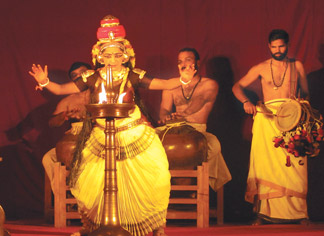Sri Lankan Tamil indigenous Koothu forms
Subashini Pathmanathan
The term 'Koothu' was generally used in Tamil to refer the dance
form. That's why the dancing deity Lord Nataraja is often referred to
numerous names connected to the term Koothu. Koothapiran, Koothandavan
and Kootharasan are some of the names referred to Lord Nataraja. The
ancient Sanskrit stage was often referred to Koothambalam. The ancient
Tamil classic Silapathikaram was enacted by the royal ascetic
Illangoadikal in second century A.D. This ancient Tamil classic
Silapathikaram mentions numerous Koothu forms existed at that time.,
Adiyarkunalar the commentator on Silapathikaram wrote the first
commentary on Silapathikaram after thirteen century of its enactment.
 |
|
A Koothu
performance |
Ancient Tamil literary work 'Kootha nool' mentions that dance
originated from drama and drama originated from dance. In ancient times,
there was no proper separation between the dance and drama. Initially
dance and drama were considered as one and the same art form. But with
the passage of time both these art forms were gradually separated from
one another. And latter they maintained their own identity and
originality.
Regional practices
Today in Tamil the word Koothu means folk dance. It is generally
referred to as Koothu Kalai. These folk dance or dance forms are
normally influenced by local culture, tradition and regional practices.
Further these Koothu forms are also called Naatu Koothu. The Tamil word
Naatu means country or village.
At regional level the Tamil Sri Lankan folk dances were divided into
three different divisions. One is Eastern indigenous dance forms, other
is Northern regional folk dances including Manner district, Vanni
district and Jaffna district folk dances. And other regional Tamil folk
dance is based on upcountry Tamil folk dances. Thenmodi Koothu and
Vadamodi Koothu forms are quite popular both in the northern and eastern
regions of Sri Lanka. The Tamil folk dances are practised, preserved and
protected in the Tamil dominated areas of Sri Lanka. Earlier these
Koothu forms were well protected and preserved by Annaviyars. Annaviyars
were the males practicing Koothus.
The approach of practising Thenmodi Koothu is quite different from
Vadamodi Koothu. Both these Koothu forms are differed from one another
especially on the basis of Thala Kattu (rhythm and tempo). Batticaloa
district in the eastern province of Sri Lanka is famous for traditional
Koothus. Batticaloa Koothu forms are more or less accompanied with two
main instruments named Drums and Thalam. Meanwhile Thenmodi Koothu
practised in Jaffna is always accompanied with more than two
instruments. It was practiced with certain selective Orchestra.
Traditional arts
Professor. S. Maunaguru's contribution is immeasurable to preserve
the traditional local Tamil Koothu forms in the eastern Sri Lanka. He
took tremendous efforts to revive these traditional eastern Koothu
forms. To create public awareness among the masses he himself appeared
before the stage and performed. His untiring efforts even after the
thirty years of civil war, by his own efforts he protects and preserves
these traditional indigenous Koothu forms of eastern Sri Lanka from
wane.
Today after the thirty years of civil war because of him, the Tamil
world has got an opportunity to see these valuable indigenous art forms
once again in the eastern Sri Lanka. Presently anyhow it is noticeable
that all the ancient Koothu forms are strongly associated and
intermingled with dance and drama to certain extent.
It is worthy to mention here that the northern Sri Lankan indigenous
Koothu forms were survived due to the efforts of the late Professor
.Vithyananthan. In northern Sri Lanka most of the Koothu forms were
really pertained to different castes. Those Koothus were specially
practised by certain castes only. Among them, some Koothus are still
persevered by the Hindu and Christian communities together.
According to certain previous records Vadamodi Koothu, Then Modi
Koothu, Then Paangu Koothu, Vadapaangu Koothu,Vassapu Koothu,
Kathathavarayan Koothu, Kovalan Koothu, Nondi Koothu,Vilasam Koothu and
Pallu Nadakam were some of the remarkable Koothu forms were prevailed in
the northern Sri Lanka. Among them at present a very few varieties of
Koothus are existing. So far, a handful of scholars have done
considerable amount of research on Sri Lankan Tamil folk lore. Earlier
so many Koothu forms were existed, but recently due to the arrival of
numerous modern technical and electronic mass medias all the traditional
art forms have gradually lost their importance in the society worldwide.
But today many of the Sri Lankan Tamil Koothu forms are only known by
names.
|





